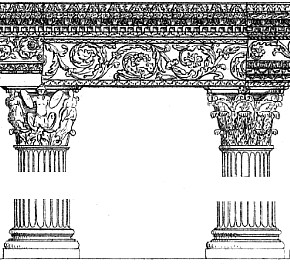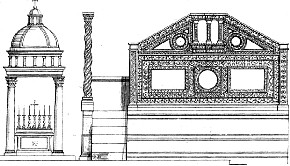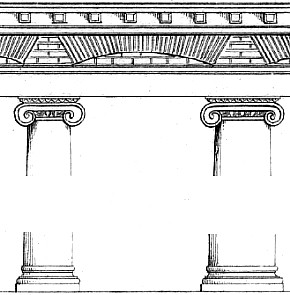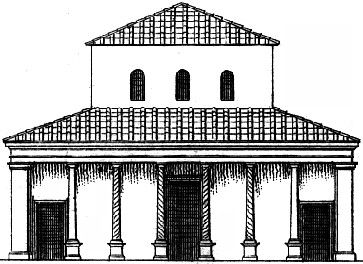
One of the inter-columniations from the choir at A D on the plan; the capital of one of the columns is Corinthian, of fine workmanship, the other composite, adorned with trophies in the center and winged Victories in the angles; the entablature, is constructed of antique fragments of great richness.

"Ciborium," or tabernacle, in marble, over the high altar; the four columns are of red porphyry.
One of the ambons or reading desks, used in the primitive church for reading the Holy Scriptures; at the side a twisted column to hold the pascal candle.

One of the inter-columniations of the nave; the columns, twenty-two in number, are of granite, chiefly of the Ionic order, but of unequal proportions, as also their bases and capitals; the manner of strengthening the architrave, to support the wall above by low arches from column to column, is worthy of remark.
| |

| |
Transverse section on the line A B; at the point A may be remarked a kind of well, to disengage one of the columns of the choir, which are concealed by the construction of the small subterranean church or Confession of the time of Honorius.
Entrance fašade of the same church, showing the portico which was added, as well as the nave, by Honorius III, in the thirteenth century; it is supported by six antique fluted columns, four of which are Greek marble, and two of the marble called Bigio; the walls are adorned with ancient fresco paintings.
Transverse section, looking towards the entrance.
Longitudinal section of the Basilica of S. Lorenzo; the choir was rebuilt in the eighth century by Adrian I, and is adorned in the lower part with some fine fluted columns, with Corinthian or composite capitals, and fragments of entablature, taken from different antique edifices; the nave is a later work, and appears to have been added by Honorius III, in the thirteenth century.
Plan of the Basilica of St. Lorenzo outside the walls of Rome. Constantine is generally regarded as the founder of this church, but it has been successively augmented and restored by the Popes Sixtus III, Pelagius II, Adrian I, and Honorius III; and in the year 1475 by Nicholas V with the assistance of Bernardo Rossellini.

Portico of the Church of St. Laurence outside the walls.
Seroux
|

Fragments of architraves, friezes, and cornices, richly sculptured, which have been taken from different antique edifices, and placed without order one after the other to form the entablature over the columns round the choir.
Bases and capitals from the same church, as varied in their ornaments as their proportions; some are antique.
Seroux
| |
|
|





